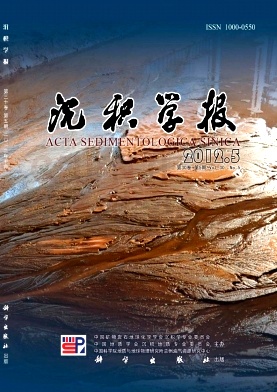Geochemical Characteristics of the Holocene Flood Slackwater Deposits in the Lower Reaches of the Jinghe River
- Publish Date: 2012-10-10
-
Key words:
- Jinghe River /
- palaeoflood /
- slackwater deposit /
- chemical elements /
- Holocene /
- /
- /
- /
Abstract: Through widespread field survey along the Jinghe River valley, a Holocene loesssoil profile with interbedded flood slackwater deposits (SWD) was found at the YGZ site at the riverbank near the Yangguanzhai village. Samples were collected systematically and the chemical elements, grainsize distribution and magnetic susceptibility were measured in the laboratory. All of these indexes showed that there are two bedsets of palaeoflood slackwater deposits in the profile. They have recorded the extraordinary palaeoflood events occurred during 4200-4000aB.P. and 3200-2800aB.P., respectively. The comparative study of the geochemical difference between palaeoflood slackwater deposits and the eolian loess and soil showed that: (1) The concentrations of major elements Fe2O3, Al2O3. K2O, MgO are higher in the palaeosol (S0) and lower in the loess (L1, Lt, L0). The abundances of elements CaO and Na2O showed a reversed change, indicating that these elements were affected by weathering and pedogenesis along with the Holocene climatic change. The abundances of trace elements including Zr, Hf, Ti, Cr, Y and they are very stable and close to the averages in the Earth's crust. This is because these trace elements are connected with the coarse fraction and heavy minerals. They have stable chemical properties and are not much affected by weathering and pedogenesis. (2) In a single palaeoflood slackwater deposit (SWD) bed, the sorted deposition in floodwater resulted in a concentration of the coarse fraction and heavy minerals at the bottom of the SWD bed. Thus, Zr, Hf, Ti, Cr, Y and other trace elements show a prominent peak. However, the increased abundance of clay minerals resulted in an increase in the major elements including Fe2O3, Al2O3, K2O, MgO in the top of a SWD bed. This change is well consistent with the change of sandsized particles and magnetic susceptibility in a SWD bed. These physicochemical features are very useful in identifying palaeoflood slackwater deposits in the eolian sediment profiles. These findings are of great importance in palaeoflood hydrology.
| Citation: | Geochemical Characteristics of the Holocene Flood Slackwater Deposits in the Lower Reaches of the Jinghe River[J]. Acta Sedimentologica Sinica, 2012, 30(5): 900-908. |






 DownLoad:
DownLoad: